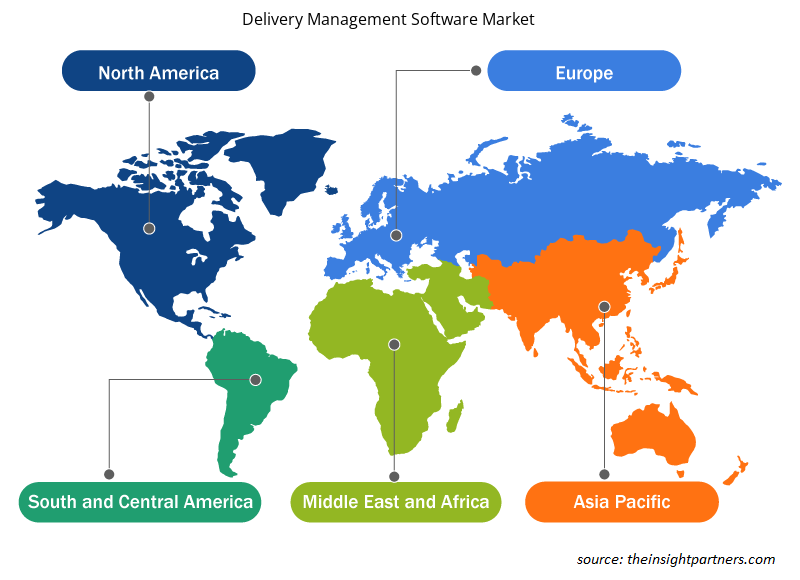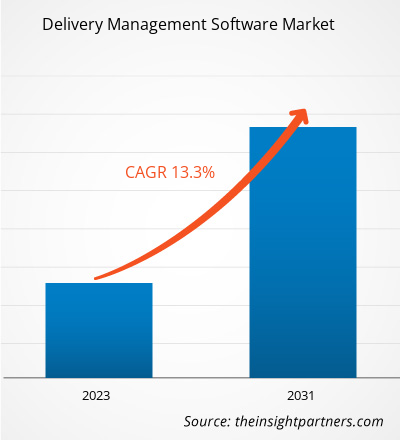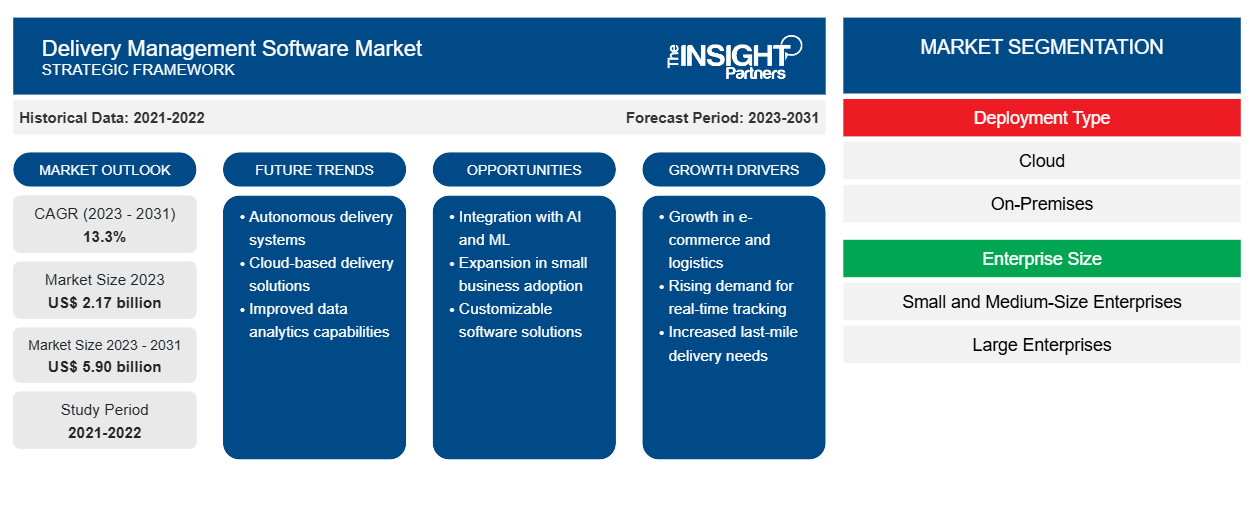من المتوقع أن يصل حجم سوق برامج إدارة التسليم إلى 5.90 مليار دولار أمريكي بحلول عام 2031 من 2.17 مليار دولار أمريكي في عام 2023. ومن المتوقع أن يسجل السوق معدل نمو سنوي مركب بنسبة 13.3٪ من عام 2023 إلى عام 2031.
من المرجح أن يظل دمج تقنيات الذكاء الاصطناعي والتعلم الآلي في برامج إدارة التوصيل لتحسين تجربة المستهلك أحد الاتجاهات الرئيسية في سوق برامج إدارة التوصيل.
تحليل سوق برامج إدارة التوصيل
يشهد سوق برامج إدارة التوصيل نموًا سريعًا بسبب توسع صناعة التجارة الإلكترونية والطلب المتزايد على المعلومات في الوقت الفعلي لإدارة الخدمات اللوجستية وسلاسل التوريد. ويتوسع السوق بشكل مطرد، مدفوعًا بالنمو السكاني وارتفاع الرقمنة وتفضيل المستهلكين للتسوق عبر الإنترنت. علاوة على ذلك، يوفر الطلب المتزايد على الأتمتة من قبل المستخدمين النهائيين فرصًا مربحة لنمو السوق.
نظرة عامة على سوق برامج إدارة التوصيل
تُستخدم برامج إدارة التوصيل لتتبع الشحنات وضمان تسليم العناصر للعملاء في الوقت المناسب. يوفر استخدام برامج إدارة التوصيل المبتكرة فوائد كبيرة للشركات، بما في ذلك زيادة استخدام الأصول وتحسين رضا العملاء وخفض استخدام الوقود. يربط البرنامج سائق التوصيل والمكاتب الخلفية على منصة واحدة ويوفر المعلومات التي يحتاجها السائق لتسليم عنصر ما. إن الطلب المتزايد على المعلومات في الوقت الفعلي وتحسين تتبع التوصيل يعزز السوق.
قم بتخصيص هذا التقرير ليناسب متطلباتك
ستحصل على تخصيص لأي تقرير - مجانًا - بما في ذلك أجزاء من هذا التقرير، أو تحليل على مستوى الدولة، وحزمة بيانات Excel، بالإضافة إلى الاستفادة من العروض والخصومات الرائعة للشركات الناشئة والجامعات
-
احصل على أهم اتجاهات السوق الرئيسية لهذا التقرير.ستتضمن هذه العينة المجانية تحليلاً للبيانات، بدءًا من اتجاهات السوق وحتى التقديرات والتوقعات.
محركات وفرص سوق برامج إدارة التوصيل
توسع صناعة التجارة الإلكترونية يقود السوق
إن التوسع في صناعة التجارة الإلكترونية والطلب المتزايد على خدمات التوصيل للميل الأخير بين المستهلكين يغذي السوق. تتوسع أعمال التجارة الإلكترونية بسرعة في جميع أنحاء العالم، حيث يفضل المزيد من المستهلكين التسوق عبر الإنترنت كخيار مناسب. يؤدي هذا إلى زيادة الطلب على خدمات التوصيل بين المستهلكين، وخاصة التوصيل للميل الأخير. يعد التوصيل للميل الأخير جزءًا مهمًا من أعمال التجارة الإلكترونية. يتضمن نقل السلع من المستودع إلى باب منزل العميل. تركز شركات التجارة الإلكترونية على ضمان وصول سلعها إلى العملاء بسرعة وبتكلفة فعالة، مما يزيد من الطلب على برامج إدارة التوصيل بين الشركات. ومع ذلك، فإن التوسع في صناعة التجارة الإلكترونية وتحول تفضيلات المستهلكين نحو التسوق عبر الإنترنت يغذي السوق.
الطلب المتزايد على الأتمتة من قبل المستخدمين النهائيين – فرصة في سوق برامج إدارة التوصيل
إن ظهور التقنيات المتطورة يمثل إمكانات نمو مربحة لسوق برامج إدارة التوصيل. حيث يقوم اللاعبون الكبار في سوق برامج إدارة التوصيل باستثمارات كبيرة في تبني تقنيات الذكاء الاصطناعي والتعلم الآلي لأتمتة عمليات التوصيل الخاصة بهم. علاوة على ذلك، تكتسب الأتمتة زخمًا كبيرًا في إدارة التوصيل من خلال دعم الشركات لتحسين إجراءات تنفيذ الطلبات والتوصيل. تساعد الأتمتة المستخدمين النهائيين، مثل توصيل المطاعم والخدمات اللوجستية وشركات البريد السريع وغيرها، على تبسيط الإجراءات وخفض التكاليف وتحسين تجربة العملاء. يتم اعتماد العديد من تقنيات الأتمتة مثل تحسين المسار وبوابات الخدمة الذاتية والتسليم الآلي بشكل كبير من قبل شركات الخدمات اللوجستية لتسليم المنتجات بشكل أسرع وأكثر فعالية.
تقرير تحليل تجزئة سوق برامج إدارة التوصيل
إن القطاعات الرئيسية التي ساهمت في اشتقاق تحليل سوق برامج إدارة التسليم هي نوع النشر وحجم المؤسسة والمستخدم النهائي.
- بناءً على نوع النشر، ينقسم سوق برامج إدارة التسليم إلى السحابة والمحلية. احتل قطاع السحابة حصة سوقية أكبر في عام 2023.
- من حيث حجم المؤسسة، ينقسم سوق برامج إدارة التسليم إلى شركات صغيرة ومتوسطة الحجم وشركات كبيرة. احتلت شريحة الشركات الكبيرة حصة سوقية أكبر في عام 2023.
- على أساس المستخدم النهائي، يتم تقسيم السوق إلى توصيل المطاعم والخدمات اللوجستية وأعمال البريد السريع وغيرها. احتل قطاع الخدمات اللوجستية الحصة الأكبر من السوق في عام 2023.
تحليل حصة سوق برامج إدارة التوصيل حسب المنطقة الجغرافية
ينقسم النطاق الجغرافي لتقرير سوق برمجيات إدارة التسليم بشكل أساسي إلى خمس مناطق: أمريكا الشمالية، ومنطقة آسيا والمحيط الهادئ، وأوروبا، والشرق الأوسط وأفريقيا، وأمريكا الجنوبية/أمريكا الجنوبية والوسطى.
من حيث الإيرادات، استحوذت منطقة آسيا والمحيط الهادئ على أكبر حصة في سوق برامج إدارة التوصيل، مع توسع قطاع التجارة الإلكترونية، ونمو عدد السكان، وتفضيل المستهلكين للتسوق عبر الإنترنت. إن الطلب المتزايد على برامج إدارة التوصيل بين الشركات لتبسيط عمليات التوصيل من خلال تقليل تكاليف الخدمات اللوجستية الإضافية هو المحرك الرئيسي للسوق. وعلاوة على ذلك، فإن التقدم التكنولوجي والطلب المتزايد على البرامج المستندة إلى السحابة لإدارة توصيل المنتجات بشكل مناسب يخلق فرصًا في السوق.
أخبار سوق برامج إدارة التوصيل والتطورات الأخيرة
يتم تقييم سوق برامج إدارة التوصيل من خلال جمع البيانات النوعية والكمية بعد البحث الأولي والثانوي، والذي يتضمن منشورات الشركات المهمة وبيانات الجمعيات وقواعد البيانات. فيما يلي قائمة بالتطورات في سوق برامج إدارة التوصيل والاستراتيجيات:
- في فبراير 2024، اشترت Inspire Brands برنامج Vromo لتبسيط قنوات التوصيل. Vromo هو برنامج توصيل طعام عبر الإنترنت يدعم Inspire Brands لتشغيل عملية التوصيل من خلال توفير مزايا تتبع التوصيل للعميل النهائي. (المصدر: Inspire Brands، بيان صحفي، 2024)
رؤى إقليمية حول سوق برامج إدارة التوصيل
لقد قام المحللون في Insight Partners بشرح الاتجاهات والعوامل الإقليمية المؤثرة على سوق برامج إدارة التوصيل طوال فترة التوقعات بشكل شامل. يناقش هذا القسم أيضًا قطاعات سوق برامج إدارة التوصيل والجغرافيا في جميع أنحاء أمريكا الشمالية وأوروبا ومنطقة آسيا والمحيط الهادئ والشرق الأوسط وأفريقيا وأمريكا الجنوبية والوسطى.

- احصل على البيانات الإقليمية المحددة لسوق برامج إدارة التوصيل
نطاق تقرير سوق برامج إدارة التوصيل
| سمة التقرير | تفاصيل |
|---|---|
| حجم السوق في عام 2023 | 2.17 مليار دولار أمريكي |
| حجم السوق بحلول عام 2031 | 5.90 مليار دولار أمريكي |
| معدل النمو السنوي المركب العالمي (2023 - 2031) | 13.3% |
| البيانات التاريخية | 2021-2022 |
| فترة التنبؤ | 2023-2031 |
| القطاعات المغطاة |
حسب نوع النشر
|
| المناطق والدول المغطاة |
أمريكا الشمالية
|
| قادة السوق وملفات تعريف الشركات الرئيسية |
|
كثافة اللاعبين في سوق برامج إدارة التسليم: فهم تأثيرها على ديناميكيات الأعمال
يشهد سوق برامج إدارة التوصيل نموًا سريعًا، مدفوعًا بالطلب المتزايد من المستخدم النهائي بسبب عوامل مثل تفضيلات المستهلكين المتطورة والتقدم التكنولوجي والوعي المتزايد بفوائد المنتج. ومع ارتفاع الطلب، تعمل الشركات على توسيع عروضها والابتكار لتلبية احتياجات المستهلكين والاستفادة من الاتجاهات الناشئة، مما يؤدي إلى زيادة نمو السوق.
تشير كثافة اللاعبين في السوق إلى توزيع الشركات أو المؤسسات العاملة في سوق أو صناعة معينة. وهي تشير إلى عدد المنافسين (اللاعبين في السوق) الموجودين في مساحة سوق معينة نسبة إلى حجمها أو قيمتها السوقية الإجمالية.
الشركات الرئيسية العاملة في سوق برمجيات إدارة التسليم هي:
- شركة ديليفورس للتكنولوجيا الخاصة المحدودة
- فارآي (روبوتيك وارز المحدودة)
- شركة جيت سويفت المحدودة
- أعمال الغابة
- شركة لوجينكست سوليوشنز الخاصة المحدودة
- شركة موبيسوفت انفوتيك المحدودة
إخلاء المسؤولية : الشركات المذكورة أعلاه ليست مرتبة بأي ترتيب معين.

- احصل على نظرة عامة على أهم اللاعبين الرئيسيين في سوق برامج إدارة التسليم
تقرير سوق برامج إدارة التوصيل والتغطية والمنتجات النهائية
يوفر تقرير "حجم سوق برامج إدارة التسليم والتوقعات (2023-2031)" تحليلاً مفصلاً للسوق يغطي المجالات التالية:
- حجم السوق والتوقعات على المستويات العالمية والإقليمية والوطنية لجميع قطاعات السوق الرئيسية التي يغطيها النطاق
- ديناميكيات السوق مثل المحركات والقيود والفرص الرئيسية
- الاتجاهات المستقبلية الرئيسية
- تحليل مفصل لقوى PEST/Porter الخمس وSWOT
- تحليل السوق العالمي والإقليمي الذي يغطي اتجاهات السوق الرئيسية واللاعبين الرئيسيين واللوائح والتطورات الأخيرة في السوق
- تحليل المشهد الصناعي والمنافسة الذي يغطي تركيز السوق، وتحليل خريطة الحرارة، واللاعبين البارزين، والتطورات الأخيرة
- ملفات تعريف الشركة التفصيلية
- التحليل التاريخي (سنتان)، سنة الأساس، التوقعات (7 سنوات) مع معدل النمو السنوي المركب
- تحليل PEST و SWOT
- حجم السوق والقيمة / الحجم - عالمي، إقليمي، بلد
- الصناعة والمنافسة
- مجموعة بيانات إكسل
التقارير الحديثة
تقارير ذات صلة
شهادات العملاء
سبب الشراء
- اتخاذ قرارات مدروسة
- فهم ديناميكيات السوق
- تحليل المنافسة
- رؤى العملاء
- توقعات السوق
- تخفيف المخاطر
- التخطيط الاستراتيجي
- مبررات الاستثمار
- تحديد الأسواق الناشئة
- تحسين استراتيجيات التسويق
- تعزيز الكفاءة التشغيلية
- مواكبة التوجهات التنظيمية























 احصل على عينة مجانية ل - سوق برامج إدارة التسليم
احصل على عينة مجانية ل - سوق برامج إدارة التسليم